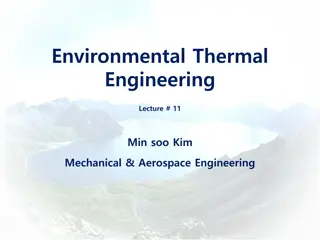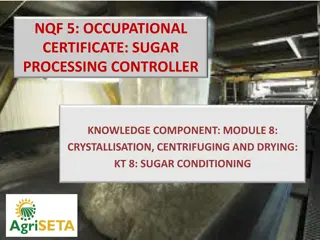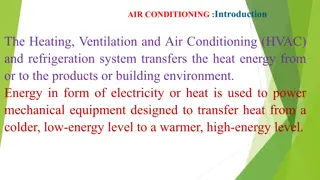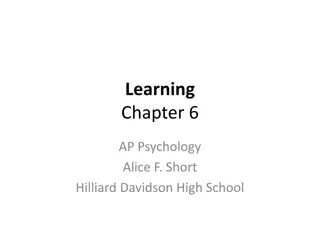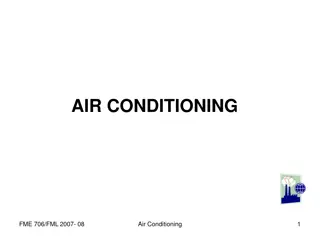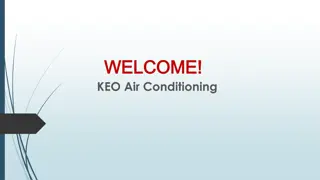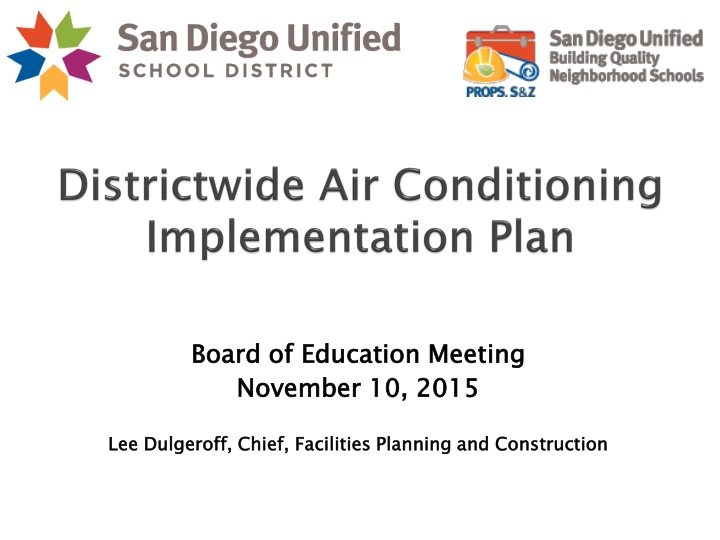
Improving Student Learning Through Optimal Classroom Temperatures
Learn how maintaining optimal room temperatures and ventilation can enhance student learning and teacher effectiveness. Explore the impact of classroom conditions on educational outcomes, safety, and efficiency. Discover the initiatives taken by the Board of Education to provide air conditioning in schools for a conducive learning environment.
Download Presentation

Please find below an Image/Link to download the presentation.
The content on the website is provided AS IS for your information and personal use only. It may not be sold, licensed, or shared on other websites without obtaining consent from the author. If you encounter any issues during the download, it is possible that the publisher has removed the file from their server.
You are allowed to download the files provided on this website for personal or commercial use, subject to the condition that they are used lawfully. All files are the property of their respective owners.
The content on the website is provided AS IS for your information and personal use only. It may not be sold, licensed, or shared on other websites without obtaining consent from the author.
E N D
Presentation Transcript
Board of Education Meeting November 10, 2015 Board of Education Meeting November 10, 2015 Lee Dulgeroff, Chief, Facilities Planning and Construction Lee Dulgeroff, Chief, Facilities Planning and Construction
Temperature and Student Learning Air Conditioning at San Diego Unified Implementation Plan Air Conditioned Spaces Schedule Design and Construction Cost Minimize Impact to the General Fund Energy Conservation Measures 2 2
The preponderance of data of safety, absenteeism and efficiency leads to the conclusion that human performance deteriorates rapidly at a temperature above or below a relatively narrow comfort zone. Students experience approximately a two percent reduction in learning ability for every degree a room fluctuates from the optimum. Council of Educational Facility Planners journal article by C. William Day 3 3
Researchers have been studying the temperature range associated with optimum learning for several decades and concluded: Students perform mental tasks best when room humidity is between 40-70% and temperatures range from 68 to 74 degrees Fahrenheit Teacher effectiveness and morale are similarly impacted by classroom temperature Adequate Ventilation is essential Proper oxygen levels are also essential to achieving optimum performance in logical reasoning and arithmetic Source: EPA Study 4 4
1999 Climate Study Initiated Established three climate zones Zone 1 = coastal Zone 2 = central Zone 3 = inland 2001 Ceiling Fan Initiative Board directed staff to utilize passive measures for hottest schools Ceiling fans, window tinting, etc. 2008 Prop S passed; included A/C for Zone 3 2012 Prop Z passed; included A/C for Zone 2 2013 HVAC 2000 Board directed staff to expedite A/C for 2000 hottest classrooms 5 5
Expedited air conditioning in remaining qualifying spaces in all climate zones Three-year implementation plan starting in January 2016 Template approach: Standardized systems Individual, rooftop package units Fast-track process for design, DSA review and procurement Separate expedited project and WSM Minimize impact on schools during construction Work performed after school hours, including evenings, weekends, and vacations 6 6
Indefinite Delivery Indefinite Quantity (IDIQ) Competitively bid construction contracts based on estimated quantities Allows for a large amount of work across multiple sites in a condensed timeframe Individual A/C projects scheduled according to heat ranking Whole Site Modernization (WSM) Schools scheduled to start their WSM by 2018, will receive A/C under that project HVAC will be incorporated into the overall WSM project design, Installation will be performed with other WSM work 7 7
Electrical Upgrades Sufficient electrical infrastructure required A/C installation requires electrical infrastructure, transformers, switch gear, new conduit wiring and electrical panels Some schools will need power upgrades Potential periods of power outages Requires coordination with utility company 8 8
Core classrooms, assembly areas, nurses offices and other primary use spaces: Permanent Classroom Non-Permanent Classroom Assembly Space Auditorium Cafeteria Career Center Conference Rooms Core Support/Resource/Focus/Push- in/Pull-out room Counselor s Office Custodial Office Faculty Lounge or Dining IDF/MDF Rooms Lecture Hall Library Multi-purpose Room Nurse/Health Occupational/Physical/Speech Therapy Parent Rooms PE/Coaches Office Pre-School/Headstart PrimeTime Principal/Staff Office Reception/Waiting Area School Police Office Stage Student Center Study Hall Testing Room Theatre Vocational Classroom (excluding shops) Work Rooms One-on-One Instruction/Small Group Instruction/Behavior Modification Room 9 9
To conserve energy the following types of spaces will not be air conditioned: Kiln Rooms Kitchens Restrooms Showers Storage Spaces Supply Rooms Team/Locker Rooms Gymnasiums Interior Corridors PE Prep Weight Training Wrestling Rooms Dance Studios Vocational Shops (Woodshop, Auto Shop, Metal Shop, etc.) 10 10
DESIGN: Each A/C project at each school requires an architectural design and engineering plan Average duration three months DSA: Plans must be submitted to the Division of State Architect for review and approval prior to the start of construction Average duration three to six months BID and AWARD: A construction contract for the performance of the A/C installations must be procured through the bid and award process Average duration four months CONSTUCTION: Installation will occur either through an IDIQ contract or a WSM project Duration varies depending on type and quantity of spaces to be air conditioned 11 11
Phase 1A Board approved February 2013: 2,000 hottest classrooms Climate Zone 3 schools and some Zone 2 schools Air conditioning for classroom spaces Project complete Phase 1A - - Project Complete $110M Actual Project Complete $110M Actual Project complete Phase 1B Continuation of A/C at Phase 1A sites A/C for nurse s offices, assembly areas, and other critical spaces Project in design Installation starts in early 2016 Phase 1B - - Installation 2016 $18M Estimated Installation 2016 $18M Estimated Phase 2 (Proposed) Expedited A/C for remaining qualifying spaces in all climate zones Continuation of A/C in remaining spaces at Phase 1A sites Phase 2 (Proposed) - - Installation 2016 Installation 2016- -2019 $204M Estimated 2019 $204M Estimated 12 12
Additional Energy Cost Estimate: $2.8M Annually Maintenance Cost Estimate: Initial Year Total: $2.15M - $1.4M (maintenance) - $750,000 (trucks, tools, and equipment) Ongoing: $1.4M per year (maintenance staff and materials) Offsets: Concurrent Photovoltaic (PV) projects Modernization projects include insulation efficient windows, etc. A/C System Controls 13 13
Installation of solar panels at 16-20 schools Offset air conditioning consumption 10.5M KWhr/year $40M estimated construction/installation cost $2.8M estimated energy cost offset annually PV at 8 schools designed for installation in 2016: Nye ES Penn ES Tierrasanta ES Scripps ES Zamorano ES Mira Mesa HS Morse HS Serra HS PV at an additional 8-12 schools installed 2017 14 14










